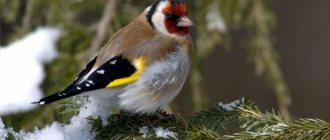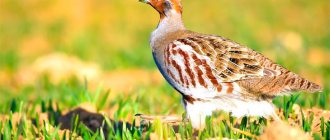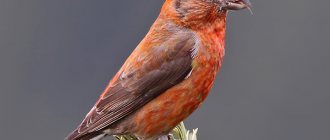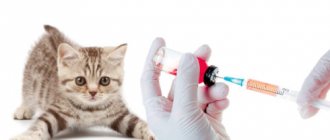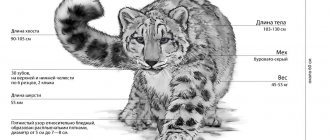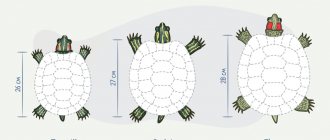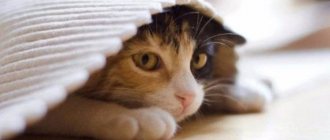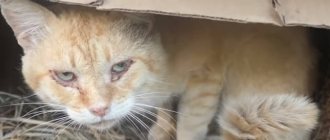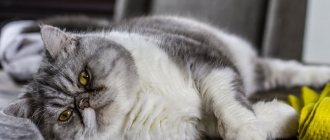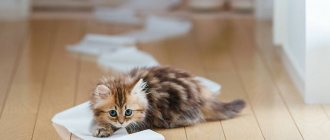Description of the river otter
This animal is very flexible and dexterous. It has a streamlined body shape. This is a rather large animal with a small head. His ears are barely visible due to his fur; they are short and located on the sides of his head. There is a special valve in the ears that closes the ear canal when the river otter dives into water. Its muzzle is short and wide, with long sideburns on the sides. The animal's neck is very thick and short, the same width as its head. The river otter has small round eyes. They are set high, which gives the animal a good view. Males, as often happens, are more massive and stronger than females. The animal's legs are short but strong. They have special membranes between their fingers. This allows you to swim better. The claws are small and short. The river otter also has a long tail. It acts as a fin and helps you move better underwater. The elongated hind legs also serve the same purpose. The animal's fur is smooth and has two layers. The top one is rougher and smoother, while the bottom one is very thick and slightly wavy. This structure of the fur allows it not to get wet and maintains the temperature of the animal at the desired level. This is what a river otter looks like. The photos presented in the article allow us to study her appearance in more detail.
Species and man
On the map of the Tver region there is a rural settlement of Vydropuzhsk, with a population of 505 people. The settlement is located on the Moscow - St. Petersburg road. According to one version, the name was formed from the description of the area in which otters lived freely.
Since ancient times, otter skins have been used as a commodity for exchange, for example, the ancient Vikings exchanged shields for it. The otter is a very valuable fur animal; its fur is considered beautiful, durable and wearable. A fur coat made from otter fur can be worn for up to 30 years, and the fur has a remarkable property - “waterproofness”. They did not learn how to raise otters in captivity; the animals were usually hunted, killing thousands for their fur, but now hunting is prohibited, since they have become a protected species.
But it was not only the valuable fur that attracted human attention to otters. It turns out that they can be used as fishing assistants. Otters began to be domesticated for this purpose many centuries ago. In the old days, the Chinese, Indians, Germans, and British did this by taming a young animal and raising it as a fishing assistant. And today, in some countries of Southeast Asia, local residents train groups of otters to drive fish into nets. Large adult animals are kept on long leashes, and growing young animals swim freely, since they usually do not swim far from their parents.
Color and voice of the animal
The animal's fur is dark brown or brown in color, while the undercoat is light brown. The color also changes on different parts of the body. For example, the sides of an otter are lighter, and the belly has a silvery tint with yellowish or brownish tints. Dark brown hair predominates on the paws and tail. A river otter can make many sounds, depending on the situation. If she gets scared of something, she will definitely start hissing. When the animals play with each other, they chirp and squeal in a peculiar way. 10 kg is the maximum weight that an animal can reach. The river otter can reach sizes ranging from 50-55 cm without a tail. The tail separately has a length of up to 95 cm. Under favorable conditions, the otter can live up to 10 years.
Habitat
This animal can live throughout Western Europe and most of Asia. The banks of streams, lakes and rivers, and in rare cases the sea coast, are considered acceptable for its habitat. When choosing a place to live, an otter will choose a river that has a fast current and a rocky bottom. There should also be plenty of fish and diving ducks. If the river is quiet, then the chance of seeing this animal there is small. The best rivers for otters are medium-sized rivers with a width of up to 15 meters. These sizes were chosen because in winter you can find a wide variety of frost-free areas.
Food and enemies
When answering the question of what the river otter eats, you need to determine the type of its diet. As you know, there are three types: herbivores, meat-eaters and omnivores. The otter is a meat eater. The basis of its diet is fish weighing up to 2.5 kg. It could be trout, pike or carp. Also, this animal does not disdain ground dwellers in the form of rabbits, various birds, frogs and rodents. It can also eat beetles and shellfish. The otter considers wolves, eagles and lynxes to be his fierce enemies, who are not averse to eating the meat of this animal.
Nutrition
The otter's diet includes mainly fish, but they can also feast on shellfish, bird eggs, crustaceans and even some terrestrial rodents. is also no friend to the muskrat , which can easily end up with the predatory animal for lunch.
Otters spend a very large part of their lives in search of food; they are quite agile and fast. Due to their gluttony, their habitats must be fishy. This animal is a wonderful hunter, so after eating, the hunt does not end, and the caught fish act as a kind of toy.
Otter lifestyle
This animal prefers to hunt at night. During the day, it rests in its hole or in the roots of trees growing near the river. If the day is hot, the otter likes to bask on the rocks or on the trunk of a fallen tree. When dusk comes, this cute animal turns into a hunter. Sea water is quite suitable for life, but the otter can only drink fresh water. She has good hearing, charm and eyesight. If this animal falls into captivity, it quickly adapts and tames, loves its owner very much and is not averse to playing with him. The otter is also very resilient. If necessary, she can walk up to 10 km per day. She builds trails and uses them for years. An interesting thing is that otters go to the same place to go to the toilet. If the area is safe and there is enough food, then these animals will not change their home. But if necessary, they can walk up to 20 km in search of a new shelter. But this only happens during the warm season. In winter, otters do not move away from unfrozen water or wormwood.
Structure of social connections
The river otter prefers to live alone. Meetings, if they occur, are only for the conception of offspring. This animal marks its territory with feces and a special secretion that is secreted from the anal glands. Males own larger areas than females. Otters usually hunt along 2-6 km of shore along the river, and they go into the water up to 100 m. Males and females can be neighbors, but the female will not tolerate another female. The relationship between males has a hierarchical structure: the dominant one takes the best territory for himself. After his displacement, this rank passes to another representative of the species.
Breeding river otters
In the second year of life, these animals begin puberty, and after a year they are able to reproduce independently. The female may be capable of conceiving several times a year. Her heat lasts up to two weeks. Meeting the opposite sex can happen both on land and in water. Fights between males are normal. The best of them receives a reward. Pregnancy lasts up to 10 weeks. After this, 2 to 4 blind puppies are born. They are already completely covered with fur. The weight of these babies is about 100 grams, and the length is about 12 cm. Mom feeds them milk from 2-3 pairs of nipples. It takes them 2-3 weeks to start crawling. At 4-5 weeks the eyes open. At the age of 7 weeks, puppies begin to learn to hunt independently. Their molars appear by 2 months of life. During this same period they learn to swim. At 3-4 months, puppies are already independent enough for their mother to leave them. When they are 8-12 months old, they leave to find their own home, but may stay with their mother for a while longer.
Where does the otter live and how does it live?
The otter lives over a fairly vast territory, covering almost all of Europe and Asia (with the exception of Switzerland, the Netherlands and the Arabian Peninsula), and it also inhabits North Africa. In Russia, the otter lives even in the Far North. The common otter is the most common species. In total, there are 5 genera and 17 species, among which the most famous, in addition to the river otter, are the Brazilian (giant) otter and the sea otter (sea otter).
The otter lives alone and leads a semi-aquatic lifestyle; it swims and dives well. When hunting for prey, the river otter can remain underwater for almost 2 minutes and swim up to 300 meters. She has an excellent sense of smell, vision and hearing. The otter most often lives in forest rivers; it also lives in lakes and ponds, and is often found even on the sea coast. The main condition is an abundance of fish.
The river otter lives in burrows, choosing hard-to-reach places along the shore. The entrance to the shelter is under water, so the otter avoids completely frozen bodies of water. It digs its own burrows extremely rarely, usually occupying abandoned burrows of other animals, such as beavers. Sometimes the otter uses caves or thickets near the water to make a den. This animal leaves the developed territory either in case of danger or due to lack of food. Also, the otter always has several spare shelters where it can hide from enemies.
Due to its rather secretive lifestyle, the river otter seems to be a completely quiet animal, but this is not so. Otters make many different sounds, they hiss, whistle, chirp and squeak. The otter lives, being active mainly in the evening and night hours, but it can also be seen quite often during the daytime. In summer, the otter often leaves its shelter to bask in the sun.
The otter animal has quite extensive hunting grounds. In summer, one otter may own a section of the river from 2 to 18 km and approximately 100 meters of the coastal zone. The river otter prefers to move along the same paths. In winter, due to freezing and glaciation of water bodies, the territory is significantly reduced, as is the food supply, which is why the otter has to roam.
The otter animal can walk on ice and snow up to 15-20 km per day. When moving on ice, it often slides on its stomach, and on snow it moves by jumping. In nature, this animal has many enemies: bears, wolves, foxes, crocodiles, large birds of prey, some species of cats and others.
The river otter has beautiful fur, which is also very durable. In the fur industry, the durability of otter fur is estimated at 100%. Usually, when processing wool, only the thick and short undercoat is left, and the coarse guard hair is plucked, resulting in very delicate and high-quality fur. Due to the quality and high value of their fur, otters often suffer at the hands of hunters, which leads to a decline in their numbers.
The use of various chemicals in agriculture and pollution of the natural habitat of otters has affected the number of these animals. In 2000, the common otter was recognized as a vulnerable species and included in the World Conservation Union's red list. In addition, the otter was included in the Red Book of the Sverdlovsk, Saratov and Rostov regions, the Republics of Tatarstan and Bashkortostan.
The otter mainly eats food that it forages in the water. The otter feeds mainly on fish, usually pike, roach, trout, carp, goby and others. When hunting for fish, it eats small specimens right in the water, but it can drag large fish onto land. The animal often plays with the caught fish and then eats it.
In addition to fish, the river otter eats various mollusks and larvae that are found in reservoirs. The otter also feeds on water voles and other small rodents, and eats frogs, lizards and bird eggs. In addition, the animal otter often hunts ducks, waders and other birds living in water bodies.
The importance of the river otter for humans
Although otters are caught for their fur, their importance in this industry is not very great. After all, only the animal’s undercoat can be beneficial to humans, because the spine is very rough and has to be plucked out. The rest of the fur is very durable, warm and light. Otters are hunted mainly because they eat large quantities of fish, causing people to suffer losses. Due to environmental pollution and expanding infrastructure, this species is not able to reproduce in sufficient numbers. Otters very often get entangled in fishing nets or die from harmful substances that enter the water thanks to humans. They hunt these animals with the help of dogs. Due to such actions on the part of people, this species is very rare. Therefore, it was included in the International Red Book. And in 1985, they even developed a special program for breeding otters in Europe.
Thus, one of the brightest representatives of the animal world of Western Europe and Asia is the river otter. The photos show how interesting and beautiful this animal is. Because of humans, it is in danger of extinction, but in recent years its population has increased.
Factors negatively affecting numbers
The decrease in the population of the Caucasian otter in the 1960-1970s was influenced by the construction of pond systems, reservoirs, rice farms, etc. In mountainous and foothill areas, the reason for the decrease in the population is the destruction of forests, which, in turn, caused an increase in surface water flow and a decrease freshwater inhabitants (crayfish, fish, frogs, etc.), which are natural food for otters.
In addition, the reduction in the number of animals was influenced by the fact that many water bodies were polluted through toxic chemicals, pesticides, oil, etc. It should also be noted that the population is negatively affected by poaching.
In order to partially restore the population of Caucasian otters, it is necessary to create nurseries and resettle the animals across the lands. In addition, the fight against poaching should be significantly strengthened, as well as responsibility for illegal hunting of animals and trade in their fur should be strengthened.
